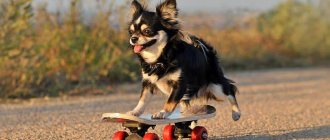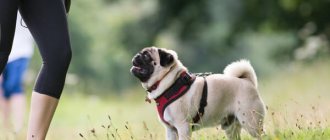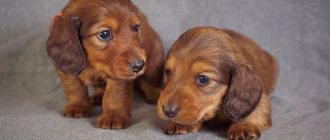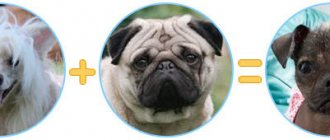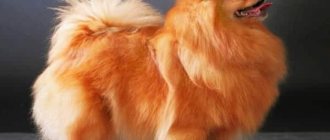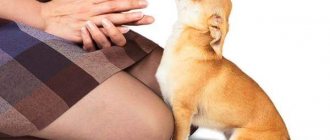Pugs are a decorative breed of dog with a friendly, mischievous character. There is a misconception that teaching basic commands to your adorable pet is not necessary. If you don’t raise and train your pug, the owner will get a lot of problems in the near future. Despite his cuteness, the dog is willful and stubborn; without training in following orders, he will become uncontrollable, capricious and lazy. A trained pug is a true friend, companion, devoted to his owner. His actions can be controlled and predicted.
Why do you need to train and raise a dog?
In order for a puppy to meet the expectations of a dog breeder, it must be raised and trained. The training process allows the pug to show all its best qualities. Such an animal is easy to keep at home, walk and travel with it. A trained pug has no bad habits, he responds to his name, knows his place, follows basic commands, and has excellent contact with family members. If you raise your pet poorly, problems may arise not only for the owner, but also for those around him. A good pug can become angry, begin to show aggression, bite or bark.
By starting training in a timely manner, they get the smart, obedient, understanding dog that one can only dream of.
Are Pugs Trainable?
As soon as the puppy appears in the house, it begins to be trained and trained. Raising a pug at 2 months is much more successful than after it matures. By the age of one year, the dog becomes slow and lazy, and it is very difficult to train it to fulfill the requirements during this period.
Pug pups have high intelligence and excellent memory, so their training is interesting. Already at an early age, a strong bond develops between the pet and the owner, built on respect and recognition of the person’s authority.
Barks constantly
The most common reason a dog barks is the desire to dominate . As a rule, in pugs it can appear at 4.5 months. In this case, the dog tests the authority of its owner and can bark and even bite quite strongly. Immediately after displaying such activity, you need to grab your pet by the withers.
Holding him in this state, press his muzzle to the floor, fix him, very sternly and coldly, in a tone that does not tolerate any objections, say “You can’t!” After this, the dog must be released and completely ignored for half an hour. If you do this every time after any, even the lightest bite, the dog will understand that he is still the boss and you shouldn’t treat him like that.
Features of education
Even at an early age, education does not always give a guaranteed result. Pugs are friendly, sociable, but stubborn. If you train your puppy correctly and conduct classes regularly, the results will not be long in coming. Several factors influence the receptivity of pugs to acquiring new knowledge:
- puppy's temperament;
- character;
- ability to obey;
- curiosity;
- aggressiveness;
- communication skills;
- vigilance, sensitivity to potential danger.
Male
To teach a pug boy, you need to be patient, perseverance and perseverance. They train him daily and give him maximum attention. A male dog should first be taught commands aimed at obedience. If a pug understands what is required of him and recognizes the owner as a leader, this is forever.
Bitches
Female pugs are more obedient and diligent than males. They quickly become attached to the owner, see him as a leader, and clearly carry out commands without additional repetitions. It is easier to train and teach girls; they are rarely capricious and stubborn, even if they don’t like orders.
How to train a pug at home?
Dog handlers recommend following the approximate instructions for training a pug at home:
- Establish close contact with the dog.
- Ensure that she does not feel fear of her owner.
- Study your pet's tastes and reward him with his favorite food.
- When performing tasks, focus on the individual characteristics of the animal.
- Conduct training at the same time.
- Do not create situations in which the animal feels equal to the owner.
Types of incentives
Physical contact through stroking brings the owner and dog closer together. By petting him, you can influence the dog's psychology.
If you stroke her sharply, with patting movements, it means that the signal has sounded to cheer up. If it’s sweeping, slow, then the dog understands that he can relax.
When training, you can use your dog's favorite toy, offering it as a reward.
The gift must be accompanied with kind words. Active methods of reward include treats. You can choose from small snacks, these include:
- a piece of sausage;
- a piece of cheese;
- some food;
- piece of chicken;
It is important that the treat be your pet’s favorite and slightly different from the usual diet.
There are several options for offering food:
- from an open palm;
- with a raised hand;
- in a static position;
How to teach commands to a pug
Not all commands are used equally often, but each is useful for interacting with a trained dog and keeping it safe in a variety of situations. You cannot begin practicing a new order until the pet learns to carry out the previous one well. It is best to carry out training in a playful way, without raising your voice, rudeness or punishment. If the dog follows commands flawlessly, he is praised and rewarded with treats.
"Lie!"
The command is practiced on the basis of the skill gained from learning the order “Sit!” The treat is brought to the nose and gradually lowered down to the front paws. As soon as the pug reaches for him, they give the command “Lie down!” and help the dog by lightly pressing on the withers.
"Sit!"
The dog is kept on a leash at the left leg, then they pull it, press on the croup and say: “Sit!” As soon as the pug follows the order, reward it. They cancel it with the next command (“Lie down!”, “Walk!”, etc.).
"Voice!"
You can make your pug bark when ordered by using his favorite toy. By teasing it and hiding it behind his back, the owner ensures that the dog begins to demand it back with his voice. They praise him and give him the toy. The training is repeated several times, after which the word “Voice!” is introduced. before your pet is about to bark. After repetitions, he will learn to bark when ordered.
“Give me your paw!”
The dog carries out the order to give a paw after he executes the command “Sit!” You need to squat down in front of him, attract attention, take his paw in your hand and lift it slightly. After holding it for a few minutes, they give the pug a treat. They practice the skill several times, accompanied by the phrase “Give me your paw!” before memorization and reflex execution.
"Near!"
The skill is practiced on the street, during walks. The owner takes a treat in his hand and encourages him to keep up with him. At the same time he commands “Near!” Gradually, as the skill becomes automatic during training, the reward is removed.
How to train a pug
Already at two months, puppies are actively trained and educated. At the first stage, training is carried out in a playful way, devoting no more than 15 minutes a day to the process. If the pugs are not tired, the lesson is repeated a few hours later. The kids will play with pleasure, because during this period they are in quarantine after vaccination, they cannot go for walks, and they are bored.
In place
Before a pug appears in the house, a comfortable place is prepared for it. The bed is placed in a cozy corner where the dog can retire and relax. You can put some of the bedding from the old place so that the baby feels a familiar smell and calms down. Then he is brought to a sunbed every time he settles down to sleep in a place other than where he is supposed to sleep. The puppy is trained to follow the command “Place!” Classes are carried out after a walk or feeding, when the dog wants to rest.
To the tray and diaper
To toilet train pugs, use the method of limiting space. Their “living territory” is fenced off with cardboard boxes, leaving a place for rest and a toilet. As soon as the baby does his business in the diaper or in the tray, he is praised and treated. In order not to miss the right moment, it is transferred there every time after eating or playing. If he refuses, newspapers are used. They cover the floor. As soon as the dog gets used to “walking” on the paper, transfer it to a tray, which is moved to the place “chosen” by the dog as a toilet.
For a walk outside
To ensure safety while walking outside, pugs must be trained in advance to use a collar, leash, harness and muzzle. They are trusting and can approach any person or animal. Pugs love to play with children or frolic with other dogs. Special sites are best suited for this.
You need to get used to relieving yourself in the same place. As soon as the dog does his business where it is supposed to, he is praised. The area is cleaned periodically.
Where to start?
The training of a pug should begin with the fact that it must get comfortable and get used to its owners. You need to teach him to respond only to his nickname; to do this, you need to call him by name as often as possible, encourage and pet the animal.
The pet must have and know a place intended for rest. feed your pug from a bowl - the slightest indulgence threatens that the food will be scattered throughout the house.
Read more about pug grooming requirements here.
Expert opinion
Kozhevin Semyon Kirillovich
Expert dog handler.
Any breed of dog must be trained and educated, regardless of whether it is a decorative dog or not. However, it is important to remember that proper reinforcement is one of the most important elements of training. At the same time, to avoid overfeeding, the treat should be divided into several parts. In addition to treats, it is important to use praise after each correctly executed command.
Training an adult pug
After the onset of puberty, even trained pugs become rebels. They do not respond to commands and try to test the boundaries of what is permitted. Raising an adult pug is much more difficult than a young one; training requires contacting an experienced dog handler. Well-known training methods are used:
- training on an empty stomach;
- carrot and stick method;
- imitative;
- coaching.
Appearance
It is easy to distinguish a pug from other breeds. This is a dog with skin folds on his head, a sad look, medium-sized with a donut tail. The Pug has a stocky, muscular body, but despite their powerful appearance, they are not very fond of physical activity.
- The coat is short, shiny, soft. Colors acceptable are beige or apricot, black. Light colors are accompanied by a black mask on the face and blackness behind the ears.
- The skull is large, classic brachycephalic. The muzzle is flat, strongly shortened with clearly defined wrinkles.
- The eyes are black, deep-set, not small, round in shape. The nose is black, located in the center of the muzzle.
- The jaws are massive with a strong chin. According to the standard, pugs should have a hearty snack.
- The ears are small and hang on thin cartilage.
- The body is heavyset with a well defined chest.
- Limbs of medium length, set parallel.
- The tail is short in length, set high and curled.
How to scold a pug?
If a pug has committed a crime, he should feel guilty. To do this, the owner makes a serious face, calls the pet to him, leans towards him and looks sternly into his eyes. In an angry, decisive voice he says that the dog is bad and you can’t do that. There is no need to wave your hands or fingers in front of your muzzle. You can shake a folded newspaper or sheet of paper.
In case of a serious offense, they are deprived of close contact for a day or two. A longer boycott does not have an effect, since the pugs forget what they have done very quickly.
How to calm a pug?
If the dog is too carried away by the game and does not listen, he is left alone, distracted with a treat or toy, or sprayed with water from a spray bottle.
If your dog is scared during a thunderstorm or fireworks, you need to find shelter, sit next to it and calm it down with approving words.
They are accustomed to traveling in a car from the very first days - they do not feed 2 hours before the trip, they create comfortable conditions, and take their favorite toys with them.
Character
All pug owners highlight their character traits such as good nature and love. At puppy age they are quite active, but as they grow, the need for movement and games gradually fades into the background, and the first place in their life is occupied by the master's sofa. The pug is ready to spend the whole day on soft bedding, distracted only by food and communication with the owner. They have a very reverent attitude towards their family members; a long separation is fraught with stress for the dog. On the other hand, they very quickly get used to strangers, so when planning a vacation, you can safely leave your pet under the supervision of friends.
Pugs are one of the most phlegmatic breeds. In addition, they are not at all capricious and unobtrusive. So you can be sure that your pet will never refuse you communication and will be next to you as much as you want.
Pugs rarely bark, including when they are alone in an apartment, so you won’t hear any complaints from your neighbors. However, this does not mean that Pugs are quiet dogs. They constantly make various sounds - puffing, grunting, snoring. And you will also be surprised by the rollicking snoring, which you wouldn’t expect to hear from such a small dog.
What to do if your pug doesn't listen?
If reward and punishment methods do not work and your pug exhibits uncontrollable behavior, you should contact a professional. You can correct your character if you follow the rules:
- Become a leader for the dog.
- Conduct training both on the street and in the house.
- Act consistently in the educational process.
- Show affection, but in moderation.
- Pay attention to your pet's minor misdeeds.
Origin story
For the first time, descriptions of medium-sized dogs with short faces are found in ancient Chinese books. Two varieties are mentioned - with short hair (Lo Jie) and with long hair (Ha Pa). Smooth-haired, according to one version, were the ancestors of modern pugs. However, India, in turn, also claims to be called the birthplace of pugs. Based on the fact that the Mahabharata mentions dogs very similar in description to pugs. And if this is true, then this breed is already several thousand years old!
According to experts, brachycephaly and flattening of the skull in pugs began due to inbreeding, which ancient dog breeders were fond of. It is believed that pugs descended from dwarf mastiffs that lived with Buddhist monks. Dogs of this breed were very loved in the palace of the Chinese emperor. Each pet had his own servant, who fulfilled his every whim. And the reason for such popularity is quite interesting - deeply religious Chinese believed that the folds on the forehead of a pug meant a secret message from Buddha. And besides, in appearance, these dogs looked very much like the mythical lions, the same stocky and flat-faced ones, which the Chinese considered to be divine guardian angels.
